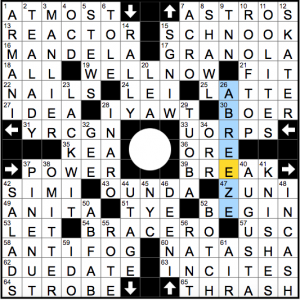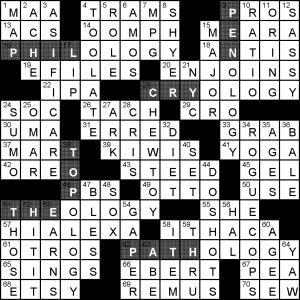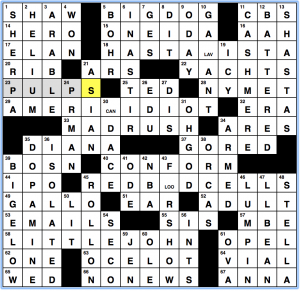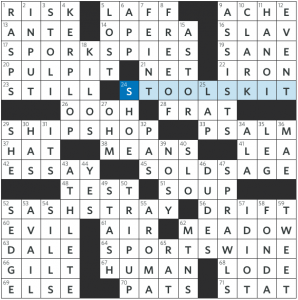Peter Gordon’s Fireball crossword “Themeless 122” —Jenni’s write-up
The Fireball gives us a gentle re-entry after taking a Thanksgiving break. Or maybe I was just on Peter’s wavelength. It was a pleasant six minutes.
I have a feeling the seed entry for this grid was 64a [President Nursultan Nazarbayev’s country, in his preferred spelling]: QAZAQSTAN. We see it more often as Kazakhstan. This piece from 2017 explains the country’s change of official alphabet from Cyrillic to Latin and includes a link to an article about the traditional nomadic game of kokpar, or “goat grabbing.” And yes, I did read the article about kokpar. We take our research seriously here at Team Fiend.
Peter makes QAZAQSTAN work with IRAQ, PREREQ, and SPITZ (the dog, not the swimmer). PREREQ is the weakest of the three and it’s not that bad. Impressive.
A few other things:
- 16a [Numbers in Italian, often] are OPERA ARIAS. That feels a little roll-your-own. I know some of you are far more opera-literate than I am, so tell me if this is a term that’s actually in the language.
- 11d [Tiki bar drink] is a PINA COLADA. I am not posting that video. You can thank me now.
- This one, on the other hand….12d [“Cheek to Cheek” singer’s declaration] is I’M IN HEAVEN.
- 13d [Ones with diminishing returns?] are TAX DODGERS. Cute.
- Sometimes it’s fun to make up words! 28d [Making outmoded] is OBSOLETING. The first page of results on Google is mostly dictionary sites – and one offer to explain the meaning of the word in Urdu.
What I didn’t know before I did this puzzle: that KAL PENN hosted “Superhuman.” I did know that Tyler Hinman appeared on the show, but clearly didn’t watch it. Sorry, Tyler.
Oh, one more thing. 50a [1960s dance] is the WATUSI so I had to find this.
Herre Schouwerwou’s New York Times crossword—Andy’s review

NYT puzzle 11.29.18 by Herre Schouwerwou
Note: The grid numbering shown in the image (at right) and used in the review below is taken from the electronic version of this puzzle. The print version has different numbering because some of the theme entries are unnumbered; the electronic version numbers these entries so that solvers are able to toggle to them.
Visually, this grid is absolutely bonkers. There are eight arrows in black squares around the edges of the grid, plus there’s a giant circle in the center. On a Thursday, that’s a recipe for some serious trickery.
As it turns out, the central circle is meant to represent a roundabout (or, in various other dialects: a traffic circle, a rotary, a merry-go-round). The revealer is at 28d (and 43a and 29up? and 29left?), IN A RO / UND A / BOUT / WAY [Indirectly … or how some of this puzzle’s answers should be entered?]. And indeed, four of this puzzle’s entries traverse the paths that cars might in roundabouts, entering at the inward arrows and exiting at the outward arrows:
- 14d, RALLYING CRY [*”Vive la France!” or “Free Tibet!”]. This entry starts at 14-Down, then goes around the roundabout and exits on the left side of the grid.
- 37a, POWER OUTAGE [*Reason for resetting a digital clock]. Starts at 37-Across, then goes down around the roundabout and out via the bottom arrow.
- 46d, I NEED A BREAK [*”Whew, that’s enough for now!”]. Starting at the bottom inward arrow, this entry goes vertically through 46-Down, then goes around the roundabout and exits on the right side of the grid.
- 33a, SPROUT WINGS [*Become angelic, figuratively]. Starting at the right side of the grid, this entry goes around the roundabout and exits at the top of the grid.
This theme is fantastic. I love the revealer; I love the visual element of the grid; I love the way the four roundabout entries were executed. The only minor ding from me is that there were a few bits of crosswordese in the fill (OMITTER, TOLE, ACRO-, OOLITES), but they were outweighed by the superb theme and the solidity of the rest of the fill.
A few bullet points:
- I didn’t know that 1d, Giorgio ARMANI, was the [First living designer exhibited at the Guggenheim].
- Now that caller ID is ubiquitous, do people still pull prank calls like the relatively toothless one referenced at 49a, ANITA [___ Hand (name used for some prank calls)]?
- There was a bit of a gendered one-two punch at 2d and 3d with TEA LADY [Beverage server in Britain] and MANLIER [More virile].
- After I was done solving, I ended up going on a bit of a dive into the history of the BRACERO program (54a, [Seasonal migrant worker from Mexico]) of World War II and the decades following. You can read more about it here and here.
Really excellent work. This is exactly what I want from a Thursday puzzle. Until next time!
David Alfred Bywaters’s Wall Street Journal crossword, “Sands” — Jim P’s review
The title tells us that “S and S” are going to be involved somehow. It turns out they’ve been prepended to each word in well-known two-word phrases.
- 17a [Seekers of company secrets at a flatware factory?] SPORK SPIES. Pork pies. Sporks are never not funny.
- 24a [Theatrical sketch set at a bar?] STOOL SKIT. Toolkit. This one made me laugh, not because of the existing clue, but for the sophomoric clue my brain wanted.
- 29a [Place to buy a boat?] SHIP SHOP. Hip hop.
- 45a [Pundit who’s been persuaded?] SOLD SAGE. Old age.
- 52a [Wardrobe malfunction at a beauty pageant?] SASH STRAY. Ashtray.
- 64a [Pigskin source?] SPORT SWINE. Port wine. Yesterday we had the redundant LAGER BEER. Today, we have the base phrase “port wine.”
Before I caught onto the theme, I was expected the Ss to be added to the ends of words thereby making them plural. But the actual theme is much more interesting and fun. Ergo, I enjoyed it quite a bit.
There isn’t anything too flashy in the fill, probably because with six theme entries, an effort was made to keep them well separated. We do get some solid 7s in ASSISTS, ATHLETE, SPRAWLS, and the fun KER-PLOP [Sound of mud falling in water].
Three more things:
- LAFF [Informal guffaw] is weird to see in the grid. Although if it was clued [Hanna Barbera’s “___-A-Lympics”] I would have no problem with it.
- Anytime you see “Lamb” in a clue in a Shenk-edited grid, it usually refers to essayist Charles Lamb. However, that fact is only true one-third of the time today: [Lamb piece] is ESSAY, but [Lamb place] is the clue for both LEA and MEADOW.
- The grid had a definite male vibe with DUDES, FRAT, SPRAWLS, and football-related clues. Beverly SILLS, Jane FONDA, and MAE West represent, but other entries (DALE, CLARK, and LEA, for example) could have helped to balance the grid more evenly.
A good grid with a solid theme. 3.8 stars.
C.C. Burnikel’s LA Times Crossword – Gareth’s review

LA Times
181129
A number of -OLOGY words are misconstrued based on their starting parts. PHILOLOGY is, roughly, the study of ancient literature, but here taken to be the study of Punxsatawney Phil. One or two – PENOLOGY, a branch of criminology dealing with punishment, the penal system; and CRYOLOGY, the study of refrigeration – are a tad obscure, but since you get very easy clues and five free letters, the -OLOGY is always repeated, the puzzle is still easy.
C.C. has actually gone for the maximum block count of 42 (the LA Times maximum is higher than most puzzles). This has meant that despite the busy theme, the grid doesn’t feel constrained. There are actually some top-drawer entries: ASIFICARE and TOOLATE made for a chatty top-left. At the bottom, HIALEXA could easily be a themeless seed to build a puzzle around. Centrally, CHEWTOY is also great, though our puppies prefer freebies – around me it looks like a rogue beaver has run riot, but its just Solo, our six month-old foster failure mutt, who has been demolishing a stick, and is actually past out with the stick still in his mouth. We also have ROGUECOPS and DOSHOTS. Will ROGUECOPS is topical, it may not be so pleasant a topic of discussion – YMMV. As I’ve said before, C.C.’s puzzles always stand out as being filled carefully to a very high standard!
3.75 Stars
Gareth
Brendan Emmett Quigley’s website crossword – “Going Places” — Ben’s Review

BEQ 11/29 — “Going Places”
This one’s coming in late, so let’s keep things brief. This week’s BEQ Thursday is full of bathroom humor:
- 18A: “I’m outta here” — HASTA LA VISTA
- 29A: Musical based on Green Day songs — AMERICAN IDIOT
- 45A:Erythrocytes, more commonly — RED BLOOD CELLS
- 58A: Robin Hood’s buddy, and a hint to this puzzle’s theme — LITTLE JOHN
Going places, then. It’s fine.
Other nice fill: BIG DOG, ONEIDA, MAD RUSH, OCELOT, NO NEWS, CASHMERE, DOPAMINE
3.5/5

I printed out the NYTimes puzzle using Across Lite, as I always do. Alas, there were none of the features that Andy’s copy showed–no arrows, no circle/roundabout in the middle.
The Across Lite note reads “Although this puzzle can be solved in Across Lite, the print version contains elements that the software cannot reproduce. We recommend using the PDF, or alternatively one of the other available electronic versions.”
Fantastic 5 star plus NYT Thursday! The asterisks made things a tad too easy and were unnecessary imo, but wow, what a great design and revealer. (Did the .puz version so no arrows or circle in the square for me.)
Thanks, Penguins, for calling my attention to the Across Lite note. I usually remember to look for notes with Sunday puzzles, but on other days I just print the puzzle out without looking for any instructions. Unlike you, I would have found the missing visuals helpful–indeed, necessary.
YW. I read the note afterward thinking it might assist the solve in some fashion.
I loved the roundabout NYT! I print the PDF, but not by going through Across Lite. I ended up with what must be the newspaper version, and it had all of the circles and arrows (but not a paragraph on the back of each one explaining what each one was, to be used as evidence against us). The roundabout in the middle was just perfect.
In recent years, the Charlottesville area has constructed several roundabouts, and I have become an enthusiastic fan. They keep traffic flowing (assuming the signage is good) and I find them easy to negotiate.
I loved the puzzle. I think I love the parenthetical remark in your first paragraph even more. I would sit next to you on the bench.
I should go look up the regional difference between “roundabout” and “rotary.” I use the latter and mostly think of rotaries as a NJ thing.
> I would sit next to you on the bench. <
The ultimate compliment ;) Thanks, Jenni!
NYT – outstanding puzzle. I loved how Herre negotiated the turns without sacrificing quality. Funny, I grew up in rural Virginia, where we didn’t have traffic circles. Then I went to college in Cambridge, Mass, wheah I not only had to learn cahs go around rotaries in the Boston area, but also that drivahs ah expected to plunge into them with blind faith – hopefully, while not squeezing theih eyes shut. The rule is that he/she who has the oldest cah, and thus has less feah of dings, wins. For the last thirty years, I’ve lived in South Jersey, where traffic circles, are called… traffic circles.
I’m thinking that my 18-year-old VW Passat Turbo would be right at home in those Boston rotaries. It would be able to plunge in madly, without a care in the world.
What I remember about the one day I spent driving in Boston in the 1970s is that if I looked another driver in the eye, I had lost. Also, when I pulled over to let an emergency vehicle go by, I was not allowed back in.
I did make it home eventually ;)
“Rotary” is a New England thing. “Traffic circle” is common in the Northeast, with plain old “circle” most common in NJ. “Roundabout” has a diffuse spread primarily in the Midwest and West. See the dialect survey results here and the heat map here.
To a traffic engineer, roundabouts, rotaries, and traffic circles have distinct designs and operating characteristics. A roundabout (or modern roundabout) has splitter islands that separate entering and exiting traffic, and deflect and slow entering traffic. Entering traffic must always yield to circulating traffic. The design speed is relatively low.
Rotaries are an old-style circular intersection that typically has a larger diameter and higher speed, and may require changing lanes between intersection legs. On some rotaries, circulating traffic must yield to entering traffic. These characteristics can make rotaries challenging to negotiate.
Neighborhood traffic circles are smaller and may be uncontrolled or stop-controlled, and are usually unchannelized.
If your only experience is with neighborhood traffic circles or rotaries, you might be surprised at how smoothly and efficiently roundabouts can operate.
As I said above, I LOVED this puzzle. I started the puzzle on the computer and when I ran into the unclued entries, I doubled back for the PDF. This is a wonderful way to start the day.
I loved the NYT concept here! I think the presentation left something to be desired however.
I solved in the NYT app, and finished all of the non-theme letters in an average Thursday puzzle time. But to figure out the the remaining letters and how the arrows and center worked took me equally as long; I stared at the screen with no activity, trying to understand the visual element (my weakness, truly), for an extremely long time.
So that was an issue for me. Once completed I could admire it, but the presentation of the arrows especially actually confused me more than helped.
I am not sure what the best way to design this would have been.
But I have full respect for the constructor on this concept and fill!
I tried to solve in AcrossLite as always, and had most of the ‘ordinary’ fill completed (except for BRACERO, which is new to me) and I thought I had the trick figured out when I got POWER at 37A and BREAK at 39A. That’s a strange way to say power outage, I thought, but it made me think that the unclued 39A must be linked to the asterisked 37A. But that was the wrong association to make and I couldn’t figure out the rest of the puzzle.
Then finally I noticed the note telling me I should print out the puzzle, but by that time I had lost interest and came here for the solution.
Clever construction but not my cup of tea.
Looked at the grid and thought “Parcheesi? How will that work!?” The actual mechanism was neat (though hard to solve), and I suppose the fill strain is inevitable considering the constraints and low word count.
I am *shocked* at the low rating for this Thursday NYT (3.68 average as I write this).
What do you people want? Beautiful puzzle design, elegant, fill is good with only a few weaknesses. Geez guys.
I think some people would disagree with the “fill is good” part. Some of it is unfortunately due to the constraints imposed by the beautifully designed grid, but some I’m not sure.
For me, this puzzle was like an artwork that I really admire and appreciate but not get a kick out of. Different priorities.
The NYT is a great puzzle (although it took 12 minutes longer than my average time). I’m so dense that I didn’t think of “roundabout” as a traffic roundabout; I simply followed the arrows after getting the revealer. This was just a lot of fun, as a Thursday puzzle should be.
WSJ– Is there some reason that you believe that male/female “vibes” should be the same? What other demographic groups would you like to see equalized? Teens/oldsters, Blacks/Whites, lambs/pigs, gay/straight, Dems/GOP?
Some of us really don’t care about your PC platitudes.
Some of you may not, but there are plenty who do. Representation does matter. But it’s understandable that you don’t care about such things if you’ve been well-represented all your life. That’s called privilege. If talk about representing groups other than your own turns you off, you might as well find another blog to visit, because it’s not going to stop here.
Indeed. What some call “PC platitudes” we at Team Fiend call being kind and respectful, and setting equality and justice as worthy goals. You’re welcome to start your own anti-PC crossword blog if this one doesn’t suit you.
Please don’t lecture me about your sophomoric platitudes–You know nothing about me or my beliefs. Sorry your panties got twisted.
I am glad that you are kind and respectful–even it it doesn’t include those who disagree with you. I hope you have a lot of luck “setting equality and justice” in a crossword. Perhaps you would have more luck spending some time at the border.
That was “setting equality and justice AS GOALS,” mind you. The phrase makes no sense without “as goals.”
Three fund-raiser crossword packs have raised over $50,000 for progressive charities in the past two years, mind you.
Food for thought:
http://time.com/5434381/tayari-jones-moral-middle-myth/
I don’t do the Fireball, but I’m very glad I read Jenni’s review and watched the video of the Batusi. My sister had a 45 of the Wah-Watusi (by the Orlons, I think) which I heard her play many times. So that ’60s dance is firmly implanted in my brainpan. But I’d forgotten the name of the Batman version (though I remembered the split-fingers-by-the-eyes gesture, as well as the running-hands-down-the-glove gesture). Thank you, Jenni. Great stuff.
Glad you enjoyed it!
I thought the NYT was fascinating, not to mention far more challenging for me than, it sounds like, for others. I didn’t get the fill for “indirectly” until I was otherwise done, and how to enter the four starred clues came just before that.
It didn’t help that I only dimly recalled BRACERO, didn’t recognize LACKWIT as one word or a noun, and was slowed by A BREEZE. (Must admit that entries with A or THE often feel like cheating, but I’d cut this puzzle a lot of breaks.) I also didn’t recognize ANTIFOG, but then I’m not a car person, being a New Yorker.
Indeed, I never did get the idea of a traffic circle or the connection of IN A ROUND-ABOUT WAY to the British “roundabout.” I just used the central white circle as a place to park ITAO until I found their proper place, and I couldn’t have told you why it was there. In fact, I took so long in part because I wanted to enter clues in a more circular manner than just a 90 degree turn. Oh, well.